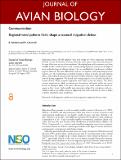Files in this item
Regional wind patterns likely shape a seasonal migration detour
Item metadata
| dc.contributor.author | Patchett, R. | |
| dc.contributor.author | Cresswell, Will | |
| dc.date.accessioned | 2020-11-23T10:30:06Z | |
| dc.date.available | 2020-11-23T10:30:06Z | |
| dc.date.issued | 2020-11-20 | |
| dc.identifier | 269886044 | |
| dc.identifier | a81a9b59-82ee-4995-9b75-18ea5526d1f7 | |
| dc.identifier | 85096520068 | |
| dc.identifier | 000595749100006 | |
| dc.identifier.citation | Patchett , R & Cresswell , W 2020 , ' Regional wind patterns likely shape a seasonal migration detour ' , Journal of Avian Biology , vol. 51 , no. 11 , e02466 . https://doi.org/10.1111/jav.02466 | en |
| dc.identifier.issn | 0908-8857 | |
| dc.identifier.other | ORCID: /0000-0002-4684-7624/work/84314954 | |
| dc.identifier.uri | https://hdl.handle.net/10023/21036 | |
| dc.description | Funding: AP Leventis Conservation Foundation. | en |
| dc.description.abstract | Migrating animals should optimise time and energy use when migrating, travelling directly to their destination. Detours from the most direct route may arise however because of barriers and weather conditions. Identifying how such situations arise from variable weather conditions is crucial to understand population response in the light of increased anthropogenic climate change. Here we used light-level geolocators to follow Cyprus wheatears for their full annual cycle in two separate years migrating between Cyprus, over the Mediterranean and the Sahara to winter in north-east sub-Saharan Africa. We predicted that any route detours would be related to wind conditions experienced during migration. We found that spring migration for all birds included an eastern detour, whilst autumn migrations were direct across the Sahara. The direct autumn migration was likely a consequence of consistent tail-winds, whilst the eastern detour in spring is likely to be more efficient given the wind conditions which are against a direct route. Such variable migration routes shaped by coincidence with prevailing winds are probably common suggesting that some birds may be able to adapt to future changes in wind conditions. | |
| dc.format.extent | 6 | |
| dc.format.extent | 428992 | |
| dc.language.iso | eng | |
| dc.relation.ispartof | Journal of Avian Biology | en |
| dc.subject | Bird migration | en |
| dc.subject | Geolocator | en |
| dc.subject | Loop migration | en |
| dc.subject | Migration detour | en |
| dc.subject | Wind | en |
| dc.subject | QH301 Biology | en |
| dc.subject | NDAS | en |
| dc.subject | SDG 13 - Climate Action | en |
| dc.subject.lcc | QH301 | en |
| dc.title | Regional wind patterns likely shape a seasonal migration detour | en |
| dc.type | Journal article | en |
| dc.contributor.institution | University of St Andrews. School of Biology | en |
| dc.contributor.institution | University of St Andrews. Centre for Biological Diversity | en |
| dc.contributor.institution | University of St Andrews. Scottish Oceans Institute | en |
| dc.contributor.institution | University of St Andrews. Institute of Behavioural and Neural Sciences | en |
| dc.contributor.institution | University of St Andrews. St Andrews Sustainability Institute | en |
| dc.identifier.doi | https://doi.org/10.1111/jav.02466 | |
| dc.description.status | Peer reviewed | en |
| dc.date.embargoedUntil | 2020-11-20 |
This item appears in the following Collection(s)
Items in the St Andrews Research Repository are protected by copyright, with all rights reserved, unless otherwise indicated.

